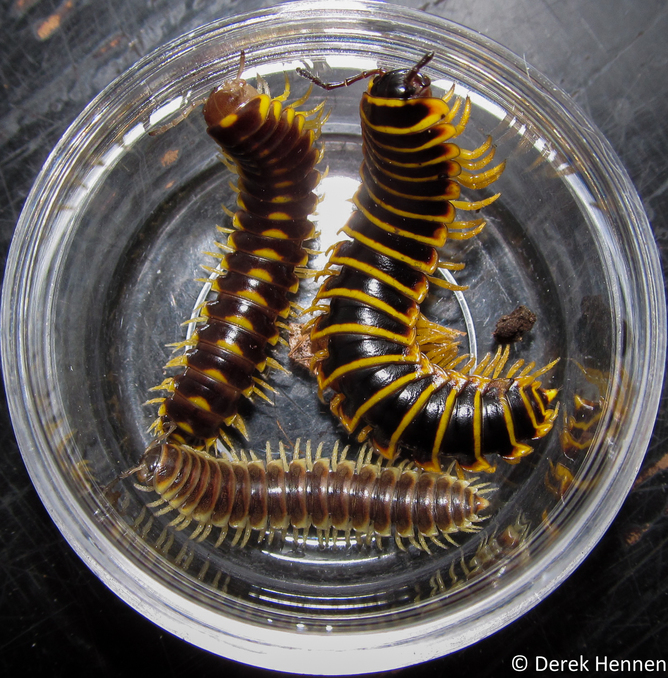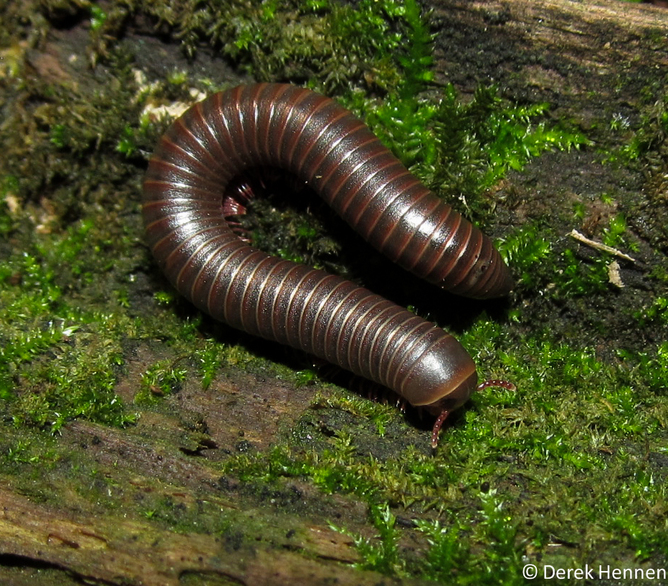The Beauty of Millipedes (Op-Ed)


This article was originally published at The Conversation. The publication contributed the article to Live Science's Expert Voices: Op-Ed & Insights.
I stumbled through the forest, attempting to find a path I knew was there. It didn’t take that long to find the decaying bridge, now being overtaken by blackberry and multiflora rose. That is where I had marked a spot for some moist leaf litter. I crouched and dug around in the litter to find an inch-long creature, chestnut-brown with pink highlights, curled up on top of the dirt. I had found my quarry.
My three-week quest was in the state of Ohio in the US. I came to collect millipedes, the many-legged cousins of insects and spiders. My goal was to survey the state’s species, photographing and collecting as many as possible during my stay.
Ohio sits on the northwestern edge of Appalachia, a hotspot of diversity for millipedes. The southern portion of the state is known for its rolling hills, and it is also where I grew up.
Millipedes aren’t particularly well known by the general public, or even by most scientists for that matter. They are not as showy as birds or butterflies, and millipede identification can be tricky.
Despite this lack of recognition, millipedes go about their daily routines as recycling machines on the forest floor. They power through the undergrowth with their many legs – two pairs on most segments, but not quite the 1,000 implied by their common name – bulldozing through the dirt and feeding on dead leaves and other detritus that accumulates on the forest floor. Millipedes return nutrients to the ecosystem and keep dead leaves from piling up in the forest.
Though millipedes aren’t known for their beauty, perhaps they should be. Many of the species I searched for are in the family Xystodesmidae, which contains some particularly dazzling specimens.
Get the world’s most fascinating discoveries delivered straight to your inbox.
Some species in that family, called cherry millipedes, can release hydrogen cyanide, a poisonous chemical, when disturbed by predators. This chemical smells like cherries or almonds, hence the name. Because it is released in small amounts, it is mostly harmless to humans. These millipedes sport bright colours paired with a dark brown or black to warn potential predators of their odorous defences.
The motivation for my research came partly from history and partly from hometown pride. A previous study of Ohio’s millipedes was published in 1928, but 86 years later, is outdated. There are few introductory resources for identifying millipedes, which stops amateurs from delving into researching these creatures.
My aim is to fix that, so the tangible outcome of my work will be a guide to Ohio’s millipede species, complete with updated ranges, colour photographs, and characteristics useful for identification. My hope is that a guide that’s accessible to the general public will spark more interest in millipedes and show people how neat the group truly is.
As for hometown pride, there are about 50 species of millipedes found in Ohio, with more still to be discovered. Some look like small, furry pincushions. Others grow to be five inches long. Some are colourful, screaming out with their contrasting blacks and yellows. Others are drab-looking but fluoresce under ultraviolet light.
My Ohio expedition took me through some of the state’s most picturesque areas, including the sandstone gorges of the Hocking Hills, where I had my best collecting day ever – 50 specimens and a dozen species. All in all, I collected more than 300 millipedes and most of the species I had set out to find.
I was fortunate to lead a few nature hikes during my trip, and the attendees found more millipedes than I did. It reminded me of how important the public is to projects like mine – I relied on many friends to identify good collecting sites, and they have sent me photos of multiple species I haven’t seen before. Interactions like that solidify my drive to introduce millipedes to a wider audience, and prove how critical it is for scientists and the public to work together to uncover the biodiversity hidden in own backyard.
Derek Hennen received funding from the Ohio Biological Survey.
This article was originally published on The Conversation. Read the original article. Follow all of the Expert Voices issues and debates — and become part of the discussion — on Facebook, Twitter and Google +. The views expressed are those of the author and do not necessarily reflect the views of the publisher. This version of the article was originally published on Live Science.
From familiar fireflies to deep sea dwellers, all sorts of organisms have evolved the ability to produce their own light. We test your knowledge of this strange and stunning phenomenon known as bioluminescence.
Bioluminescence Quiz: Do You Know About Glow?







